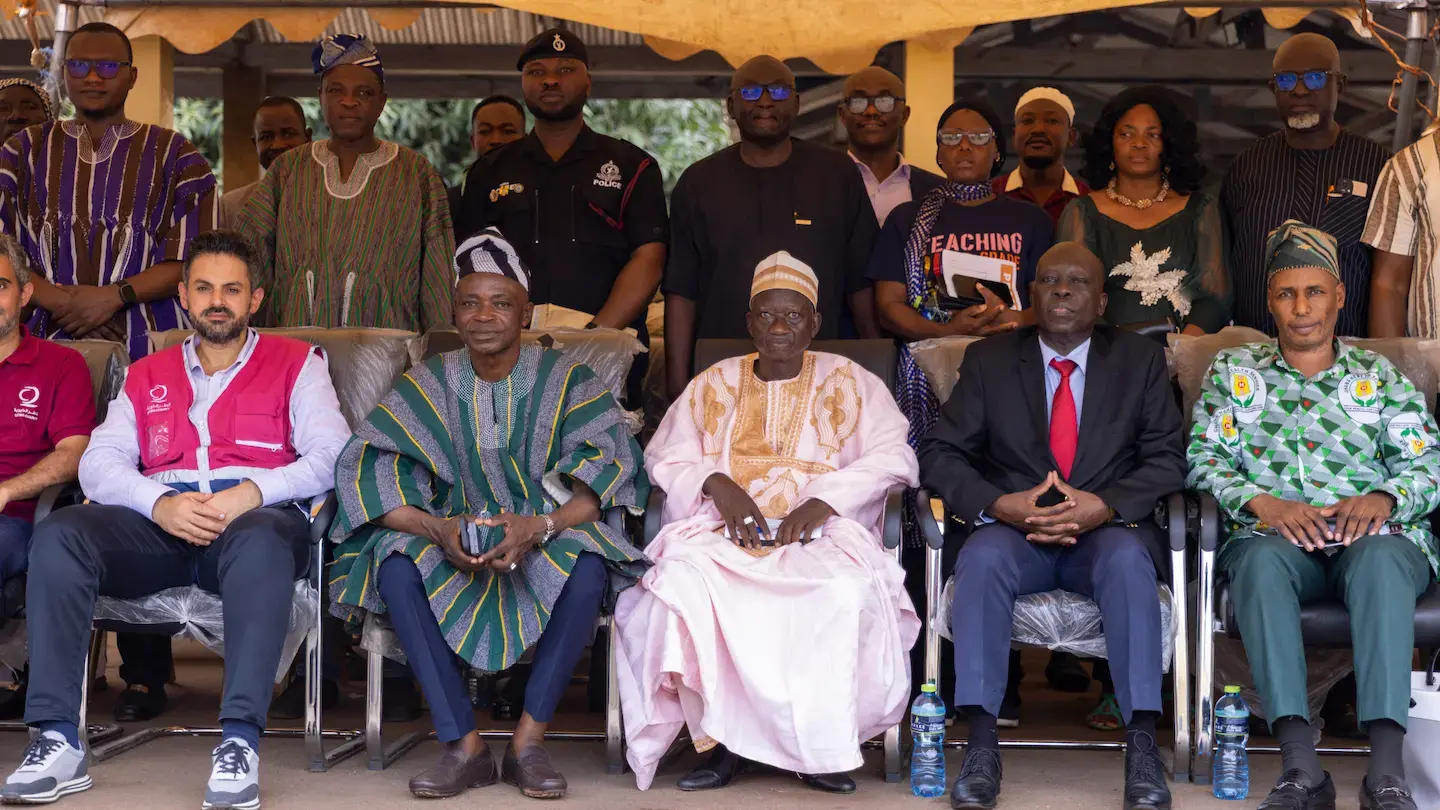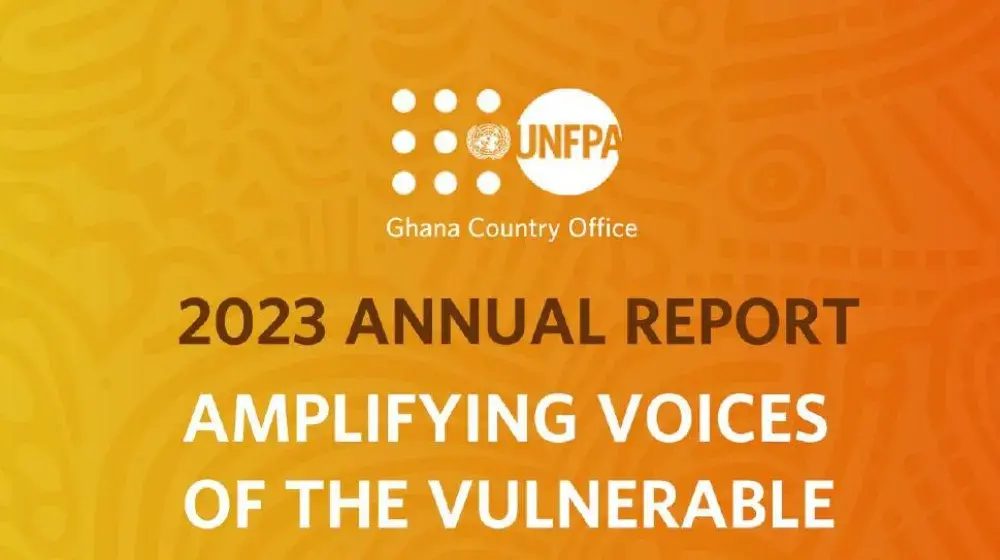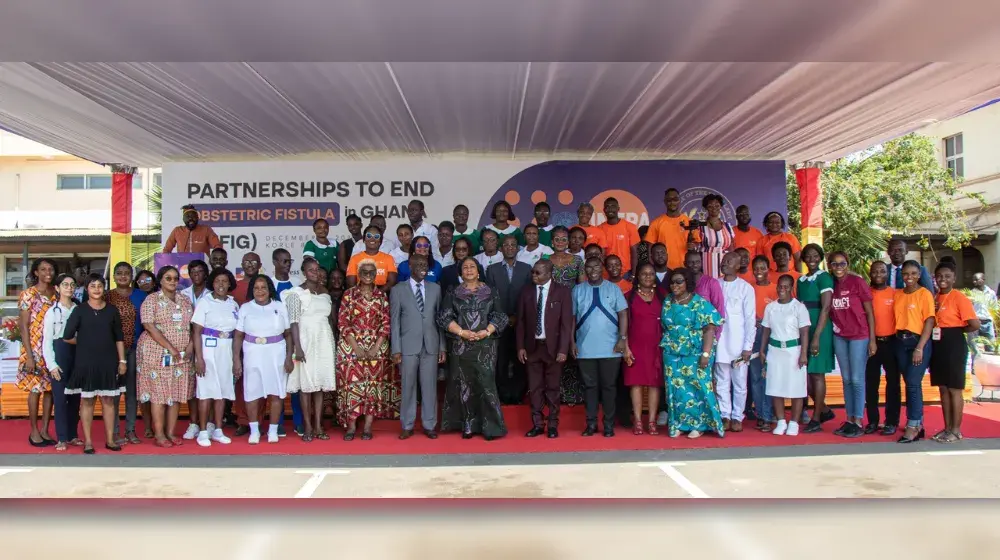Obstetric Fistula is a complication usually distressing, of a prolonged and obstructed labor without timely medical attention and usually results in the incontinence of urine and feces both through the vagina. This can lead to infections, ulcerations and a host of other complication such as depression and infertility. An estimated 50,000 to 100,000 women develop obstetric fistulas each year and it is estimated that more than 2 million young women live with untreated obstetric fistula in Asia and sub-Saharan Africa (WHO, 2018.). Even though all pregnant women may be at risk of obstetric fistula, some factors such as poverty, teenage pregnancy or early or child marriage, lack of or limited access to emergency obstetric services, malnutrition, female genital mutilation practices, lack of family planning etc contributes to higher risk of exposure to this serious condition. In 2015, a UNFPA-sponsored report on the burden of obstetric fistula in Ghana concluded that between 711 and 1,352 new cases of obstetric fistula occur annually. This correlates to an incidence rate between 1.6 and 1.8 per one thousand deliveries. No more than two hundred cases of obstetric fistula are surgically repaired each year (UNFPA, 2015).
Affirmatively, The Sustainable Development Goals (SDGs) are not only a crucial part of development, but they also constitute an essential element for attending to the universal disparities and processes leading to a sustained development. They serve as the backbone to every aspect of life ranging from planning, initiation or implementation through to holistic performance assessment and review. Particularly for Goal 3 (Good Health and Well-being) and a general target of overall positive health attainment by improving maternal health, reducing health inequalities, strengthening health systems and increasing the levels of funding and Goal 5 for Gender Equality, it is prudent to design activities, policies and programs geared towards attending to the needs of inequalities and gaps in the health care delivery services in Ghana. There exist a lot of gaps in the health service delivery in the country ranging from discrimination in the hard to reach zones or underserved communities which greatly affects the goal of the attainment of universal health coverage for all.
However, with the existence of development partners especially in the areas of eradicating obstetric fistula, there is a great breeze of hope and success in combating this when a step beyond the current practice is ensured. Poverty as a key cause of obstetric fistula resulting in teenage pregnancy, early or child marriages, malnutrition etc calls for the need to provide livelihood empowerment and support to particularly rural women. This would help women to be financially boosted to cater for basic needs for particularly their female children to prevent the temptations of these girls having to seek support from the wrong sources which could possibly land them into traps of teenage pregnancies and subsequently early or child marriages since these are established causes of obstetric fistula.
It is logical to adjudge that Ghana is experiencing a failing health care delivery following the persistent existence and increase in the conditions of especially obstetric fistula amidst some collaborations and partnerships. There is however the need to strengthen the Community-Based Health Planning and Services (CHPS) system to provide assessment, referrals (thus if suspected) for diagnosis and treatment. This can be done by empowering Community Health Nurses (CHNs) and or Community Health Officers (CHOs) by providing training to equip them with the requisite knowledge in assessing, detecting and referring cases of obstetric fistula to appropriate facilities for the necessary attention to be provided. The structure and concept of the Community-Based Health Planning and Services (CHPS) provides the platform to deliver all health services at the community level and to tailor messages of health promotion according to the needs of the various age cohorts, gender needs and or community health needs of the people hence the need to re-strategize and channel efforts towards this structure to ensure that none is discriminated especially with regards to addressing the issues of obstetric fistula.
Recognizing the efforts of the UNFPA especially with the launch of a campaign in 2003 to end Obstetric Fistula, with a goal of reducing the number of obstetric fistula patients, particularly in developing countries., rolling out an Obstetric Fistula Case Search initiative to support Community Health Nurses (CHNs) and or Community Health Officers (CHOs) through their outreach services to communities in their CHPS zones will go a long way to complimenting the already existing efforts in the fight against obstetric fistula. A paradigm shift from curative to preventive by establishing or mounting obstetric fistula diagnostic and referral services in the CHPS zones especially hard-to-reach communities will create the atmosphere to provide timely services to victims of obstructed labor in order to prevent further complications. Gender inequalities which mostly defiles the rights of women and robs them of their power to make decisions on when to give birth is a great risk of obstetric fistula hence the need to make conscious efforts to addressing this challenge. A campaign launch to empower and support women to be able to decide when to give birth. This campaign should be strategically designed to empower women and young girls on their rights to decision making and the channels to seek support when their rights are infringed on.
There is the need to establish or create youth networks to champion and serve as Sexual and Reproductive Health and Rights (SRHR) advocates or ambassadors. These youth networks must be empowered through capacity building trainings to be able to amplify and increase the level of education and create awareness amongst young people with regard to sexual and reproductive health and rights. There exist a lot of prevailing issues in areas of Sexual and Reproductive Health Rights (SRHR) affecting the development of young people notable amongst them are child marriages, teenage pregnancy, sexual and gender-based violence (SGBV) and these are in connection with the causes of obstetric fistula.
Mobilizing, training and supporting Traditional Birth Attendants (TBAs) to detect, refer or report suspected obstetric fistula cases to designated facilities and health professionals for the appropriate actions would be a great step in the fight against obstetric fistula. It is without doubt that, in most rural communities, women still choose the traditional ways of delivery over the modern ones and as such, they confide in the Traditional Birth Attendants (TBAs) with any pregnancy problems or complications. If steps or initiatives are however taken to ensure that these birth attendants become resourceful in detecting cases of obstetric fistula by trainings (training them on the signs and symptoms of obstetric fistula), it will aid in a stronger collaboration to combating this condition. However, this is not a call to contradict the fight against unskilled birth which has a lot of negative consequences but serves as a recommendation to gradually collaborate with TBAs to generally refer cases of labor to the appropriate health facilities. This, in the long run, will step by step educate and inspire the Traditional Birth Attendants (TBAs) to come to terms with the essence of skill delivery.
Initiating both static and mobile obstetric fistula assessment and detection points will also aid in early detection and treatment of this condition. The mobile assessment ones could be added to the outreach services of the Community Health Nurses (CHNs) or Community Health Officers (CHOs) as stated earlier and the static services could be mounted at some health centers or CHPS compounds in the various communities. This would be instrumental in the achievement of the universal health coverage for all Ghanaians including combating obstetric fistula.
Launching a campaign to end stigmatization on obstetric fistula victims will provide the confidence to victims of obstetric fistula to quickly recover from inferiority and shock and be able to quickly reintegrate in society. The campaign should focus on the creation of awareness to the public to understand and appreciate the pains that victims of obstetric fistula go through and for that matter, the need to give them the emotional support. This would in the long run, aid the swift recovery and comfort for victims to visit health facilities to seek medical attention. More efforts to strengthen the capabilities of health workers through trainings on how to screen for obstetric fistula (pre-surgical screening) to ensure adequacy of health professionals and staffs in addressing the challenges of obstetric fistula. There is also the need to expand and equip more health facilities to handle obstetric fistula surgeries and treatment.
In order to reduce the prevalence of malnutrition which is associated with poverty as a root cause of obstetric fistula, there is the need to lobby and collaborate with regional and district nutrition officers through Ghana Health Service (GHS) to design a roadmap geared towards engaging women particularly those in their prenatal periods to know their nutritional needs especially during pregnancy. A woman’s nutritional needs is high during such periods because most of them may be poorly nourished.
The overburden nature of our health systems have created an atmosphere for more girls and women to be repeatedly at risk of obstetric fistula. Most often than not, obstetric fistula repairs been suspended widely for the fact that, they are deemed non-urgent and chunk of the resources are diverted to care for other supposedly urgent conditions. There is however the need mobilize resources solely to addressing the issues of obstetric fistula by ensuring that there is some kind of an autonomous service care to victims of obstetric fistula since health inequalities is not helping in the fight. International support, financial mobilization and political commitment from governments for fistula prevalent countries focused on empowering governments to manage their own problems should be greatly intensified..
There is the need to gear up collaborations and partnerships with development partnerships particularly working in the areas of family planning to increase access to awareness creation for family planning services for adolescents, men and women. This would strategically assist in curbing obstetric fistula since lack of family planning puts the individual at risk of obstetric fistula. With regards to spikes in teenage pregnancy cases and child marriages in the era of COVID 19 as a result of lockdown and poverty (low economic growth) respectively, it is important to create and initiate livelihood empowerment initiatives especially in economically poor regions and communities to financially empower and stabilize young girls and women in particular as well as families. This would help address the challenges of poverty and as one of the root causes of obstetric fistula and strength the fight against obstetric fistula.
Intensifying sensitization through outreaches durbars, home visits and localize health promotion and information sharing activities through the waves of radio. Tailor messages of health promotion in terms of obstetric fistula in various local language to be discussed weekly on air, this would constantly remind people of the risk factors, signs and symptoms and the steps in seeking assistance as and when it is needed. Also, there exist groups such as Mother-To-Mother-Support-Groups (MTMSG) or Father-To-Father-Support-Groups (FTFSG) in most communities in our rural areas which basically aims at encouraging ideas sharing and supports amongst mothers particularly in achieving good health and well-being hence the need to utilize such groups by setting up volunteers or ambassadors of obstetric fistula groups in the various communities and build their human resources to be able to give weekly education and reminders on issues concerning obstetric fistula (causes, risk factors, prevention and channels to seek support) to these Mother-To-Mother-Support-Groups (MTMSG) or the Father-To-Father-Support-Groups (FTFSG) during their meetings.
Under Ghana Health Service (GHS), there is a program known as the Life Course Approach (LCA), also termed as the wellness clinic and it is designed to provide a platform to combating Non-Communicable Diseases (NCDs) which are springing up day by day in our communities through anthropometric assessment, life style modifications, physical or general assessment, diet assessment and counselling and mental counselling services. This particular program is particularly effective in the Upper West and Savannah Regions and such platform can be tapped on to strategically inculcate the services of obstetric fistula (sensitization, counselling, assessment and referrals). It is always done at various centers within communities by health staffs where community members attend weekly for health checks and assessment and a strong component of it is the Social and Behavior Change Communication (SBCC) services which would be a great opportunity to creating awareness, educating and addressing the challenges of obstetric fistula.
There is urgent need for Government of Ghana to establish and implement a time-bound roadmap to combating obstetric fistula. Government should have a clear plan for implementation on the steps, activities, programs and possibly, policies to addressing obstetric fistula. This would give a clear direction in the fight against this menace. Also, creation of an accessible obstetric fistula welfare fund to break the barriers to timely health care such as surgery cost and transportation cost will reduce the financial burden in seeking health care for obstetric fistula.
For the purpose of data to inform decisions on intervention strategies, Ghana through the Ghana Health Service (GHS) can create a column for data reporting on obstetric fistula in the District Health Information Management System 2 (DHIMS2). This would give more and vital attention to the prevalence of obstetric fistula and its related issues. Collaboration by Government of Ghana and development partners to procure and supply enough essential and life-saving medical supplies for obstetric fistula will also be a step in the right direction. Also, ensuring a universal access to reproductive health services by eliminating sexual and gender-based violence (SGBV) and fulfilling rights to awareness creation, education and health by government will be a great step in the fight against obstetric fistula.
Revamping campaign against Female Genital Mutilation (FGM) with the inclusion of intensive public education or mass education on the dangers associated with Female Genital Mutilation (FGM) as in the case of scarring around the genitals which could potentially contribute to obstructed labor or obstetric emergencies would be a great initiative to changing the narrative of obstetric labor. There is also the need to enforce the already existing laws particularly protecting girls and women from harmful practices. This will provide the platform to curbing abuses and harassments such as child marriages or pregnancy-induced marriages, teenage pregnancies etc. Constantly engaging communities, leaders (traditional and religious), families and parents to protect girls from child marriage and enlighten them on the dangers of teenage pregnancy and upholding their rights can be a key intervention to strengthening the fight against obstetric fistula.
Involving women and young girls especially victims of obstetric fistula in the process of decision making will open doors for experience sharing and ensure that favorable and appropriate intervention strategies are designed or created to combating the prevalence of obstetric fistula. Reduce local barriers to contraceptive access and comprehensive sex education and routinely organizing accountability dialogues or fora on the successes and impact of existing strategies, intervention and policies in the fight against obstetric fistula will help greatly particularly in terms of addressing the limitations in some strategies and finding solutions to them and also initiating community dialogue or discussions to ending child marriages will help in the fight.
“Eradication of obstetric fistula is not only a human right issue but also a question of equity”. It is our responsibility to provide an environment for girls to develop and express their full potentials. The success of the fight is possible with the collective efforts of all parties and partners involved
End Fistula Now!!!
Stop the stigmatization!!!
Women and Young Girls deserves better!!!
Let’s give emotional support to victims of obstetric fistula now!!!





